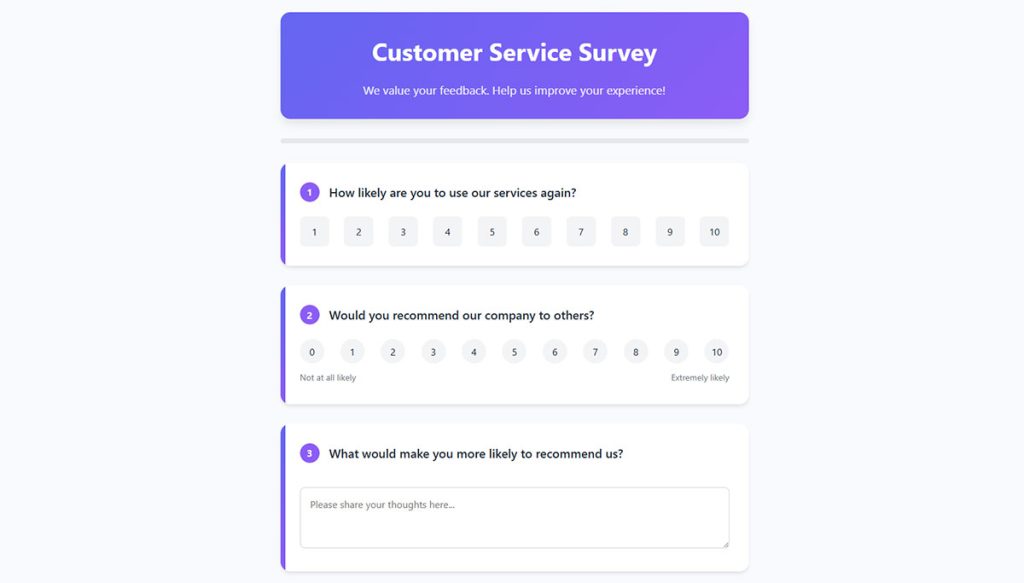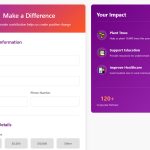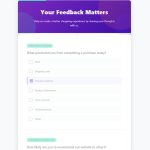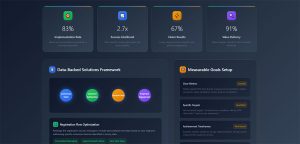One badly worded question can ruin months of research work. Every survey researcher learns this the hard way. Getting good data comes down to picking the right types of survey…
Table of Contents
Are your customer feedback loops capturing what truly matters? Effective customer service survey questions transform casual responses into actionable consumer insights.
Gathering meaningful service quality feedback requires strategic questionnaire design. With the right feedback forms and customer satisfaction measurement techniques, businesses unlock critical data points that drive improvement strategies. Today’s competitive landscape demands more than basic satisfaction metrics.
CSAT questionnaires and NPS survey design represent just the starting point. The true value emerges when you implement comprehensive voice of customer programs that track support team performance across all customer touchpoints.
This guide explores essential customer experience measurement tools, proven service evaluation methods, and strategic survey form techniques that reveal what your clients actually think. We’ll examine the full spectrum of types of survey questions that generate meaningful response data and provide best practices for creating feedback forms that customers actually complete.
Customer Service Survey Questions
Overall Experience
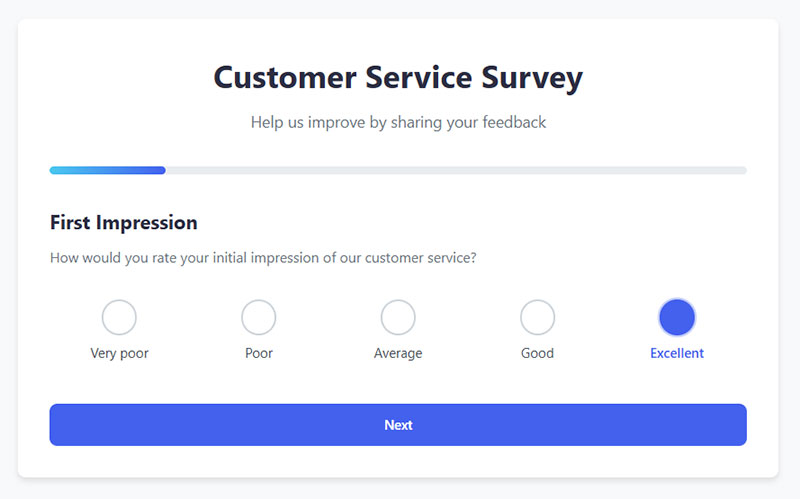
Overall Satisfaction Rating
Question: How satisfied were you with your recent customer service interaction?
Type: Multiple Choice (1-5 scale from “Very dissatisfied” to “Very satisfied”)
Purpose: Measures general customer sentiment and serves as a baseline metric.
When to Ask: Immediately after service interaction.
Issue Resolution
Question: Did we resolve your issue completely?
Type: Yes/No with optional comment field
Purpose: Determines first contact resolution rate and identifies recurring issues.
When to Ask: After service completion or case closure.
Ease of Service
Question: How easy was it to get the help you needed?
Type: Multiple Choice (1-5 scale from “Very difficult” to “Very easy”)
Purpose: Evaluates customer effort score and identifies friction points.
When to Ask: After service completion.
First Impression
Question: How would you rate your initial impression of our customer service?
Type: Multiple Choice (1-5 scale from “Very poor” to “Excellent”)
Purpose: Captures emotional response to first touch point.
When to Ask: Early in the survey.
Expectation Alignment
Question: Did our service meet your expectations?
Type: Multiple Choice (1-5 scale from “Far below expectations” to “Far exceeded expectations”)
Purpose: Measures gap between customer expectations and delivery.
When to Ask: After service completion.
Value Assessment
Question: Do you feel the service you received was worth your time?
Type: Multiple Choice (1-5 scale from “Not at all valuable” to “Extremely valuable”)
Purpose: Evaluates perceived value of service interaction.
When to Ask: After issue resolution.
Agent Performance
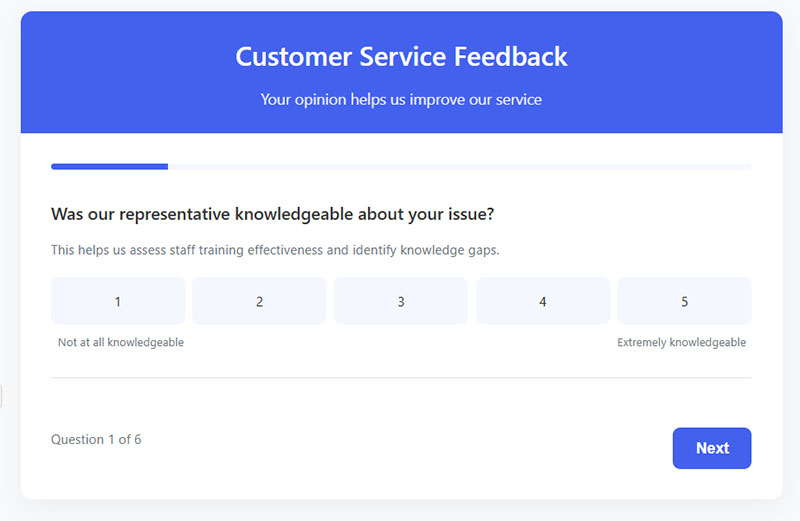
Agent Knowledge
Question: Was our representative knowledgeable about your issue?
Type: Multiple Choice (1-5 scale from “Not at all knowledgeable” to “Extremely knowledgeable”)
Purpose: Assesses staff training effectiveness and knowledge gaps.
When to Ask: After customer-agent interaction.
Communication Clarity
Question: Did the representative communicate clearly?
Type: Multiple Choice (1-5 scale from “Not at all clear” to “Extremely clear”)
Purpose: Evaluates agent communication skills and identifies training needs.
When to Ask: After verbal or written communication.
Professionalism Rating
Question: How would you rate the politeness and professionalism of our staff?
Type: Multiple Choice (1-5 scale from “Very unprofessional” to “Very professional”)
Purpose: Measures customer perception of staff conduct and service quality.
When to Ask: After customer-agent interaction.
Problem-Solving Skills
Question: How effectively did our representative solve your problem?
Type: Multiple Choice (1-5 scale from “Not at all effective” to “Very effective”)
Purpose: Assesses critical thinking and resolution capabilities.
When to Ask: After issue resolution.
Personalization Level
Question: Did you feel the representative treated you as an individual rather than just another customer?
Type: Multiple Choice (1-5 scale from “Not at all personalized” to “Highly personalized”)
Purpose: Measures perception of personalized service.
When to Ask: After customer-agent interaction.
Empathy Rating
Question: Did the representative seem to understand and care about your situation?
Type: Multiple Choice (1-5 scale from “Not at all empathetic” to “Very empathetic”)
Purpose: Evaluates emotional intelligence and customer connection.
When to Ask: After service interaction, particularly for complaint handling.
Timeliness
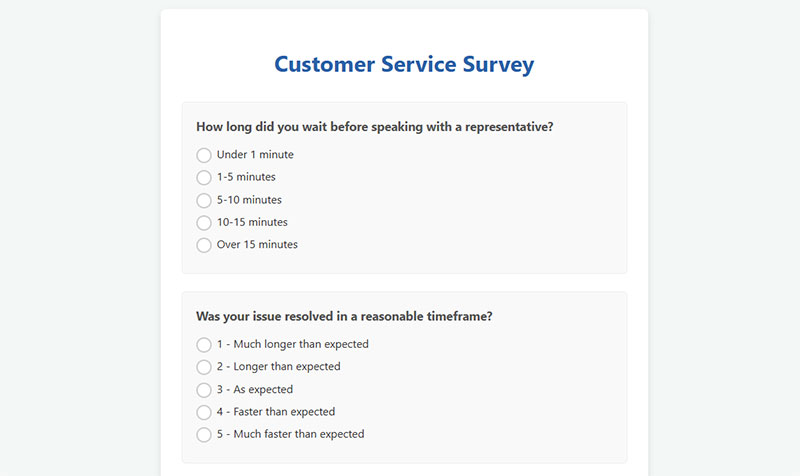
Wait Time Assessment
Question: How long did you wait before speaking with a representative?
Type: Multiple Choice (Time ranges: “Under 1 minute”, “1-5 minutes”, “5-10 minutes”, “10-15 minutes”, “Over 15 minutes”)
Purpose: Identifies staffing needs and peak time issues.
When to Ask: After initial contact and queuing.
Resolution Timeframe
Question: Was your issue resolved in a reasonable timeframe?
Type: Multiple Choice (1-5 scale from “Much longer than expected” to “Much faster than expected”)
Purpose: Measures efficiency against customer expectations.
When to Ask: After case resolution.
Response Time Satisfaction
Question: How satisfied were you with our response time to your initial inquiry?
Type: Multiple Choice (1-5 scale from “Very dissatisfied” to “Very satisfied”)
Purpose: Evaluates perception of initial responsiveness.
When to Ask: After first response received.
Follow-up Timeliness
Question: If follow-up was required, how promptly did we get back to you?
Type: Multiple Choice (1-5 scale from “Very slow” to “Very prompt”) with N/A option
Purpose: Measures consistency in follow-up communications.
When to Ask: For multi-step resolutions.
Urgency Recognition
Question: How well did we recognize the urgency of your situation?
Type: Multiple Choice (1-5 scale from “Did not recognize urgency at all” to “Perfectly recognized urgency”)
Purpose: Assesses prioritization effectiveness and customer perception.
When to Ask: After urgent issues or time-sensitive matters.
Communication
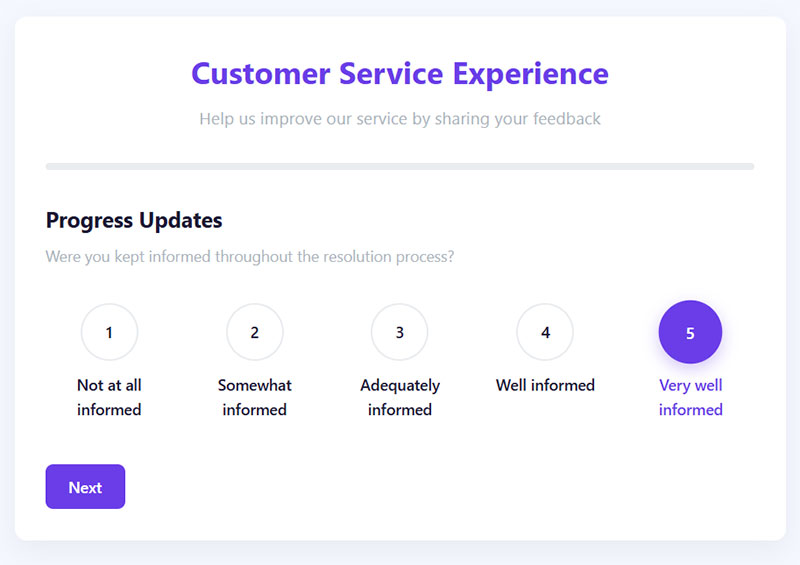
Progress Updates
Question: Were you kept informed throughout the resolution process?
Type: Multiple Choice (1-5 scale from “Not at all informed” to “Very well informed”)
Purpose: Evaluates communication frequency and transparency.
When to Ask: For multi-step or extended service interactions.
Information Clarity
Question: How satisfied were you with the clarity of information provided?
Type: Multiple Choice (1-5 scale from “Very unclear” to “Very clear”)
Purpose: Assesses quality of explanations and instructions.
When to Ask: After receiving information or instructions.
Communication Frequency
Question: How would you rate the frequency of our communications?
Type: Multiple Choice (1-5 scale from “Too infrequent” to “Too frequent” with “Just right” in the middle)
Purpose: Evaluates communication cadence and customer preferences.
When to Ask: For interactions with multiple touchpoints.
Channel Appropriateness
Question: Was the communication channel used (email, phone, text) appropriate for your needs?
Type: Multiple Choice (Yes/No with preference option)
Purpose: Identifies preferred communication channels.
When to Ask: After case resolution.
Proactive Communication
Question: Did we anticipate your questions and provide information before you had to ask?
Type: Multiple Choice (1-5 scale from “Not at all proactive” to “Extremely proactive”)
Purpose: Measures predictive service quality and proactive problem-solving.
When to Ask: After service completion.
Product/Service Feedback
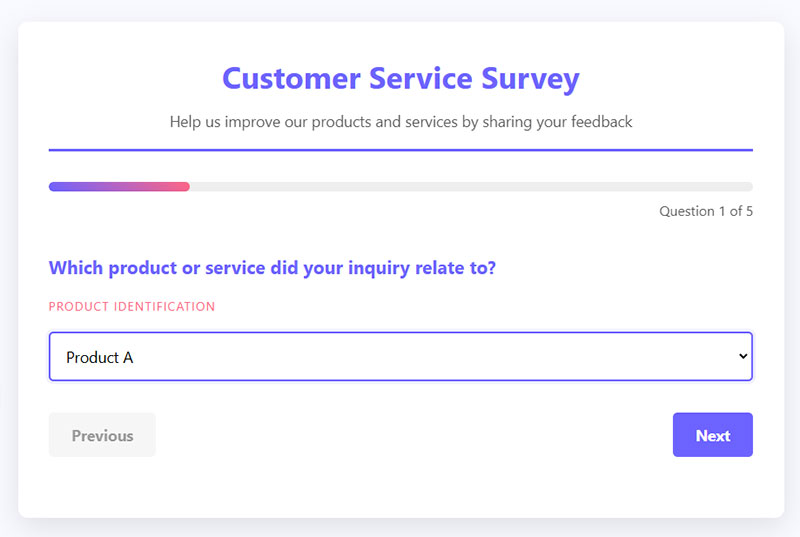
Product Identification
Question: Which product or service did your inquiry relate to?
Type: Dropdown menu or Multiple Choice (list of products/services)
Purpose: Segments feedback by product line and identifies problematic offerings.
When to Ask: Early in the survey.
Product Improvement
Question: What improvements would make this product/service better?
Type: Open-ended text field
Purpose: Gathers specific product enhancement ideas.
When to Ask: After product-specific questions.
Feature Satisfaction
Question: How satisfied are you with the features of the product/service you purchased?
Type: Multiple Choice (1-5 scale from “Very dissatisfied” to “Very satisfied”)
Purpose: Evaluates product feature quality and alignment with expectations.
When to Ask: After purchase and initial use.
Product Usage Challenges
Question: What challenges, if any, have you faced while using our product/service?
Type: Open-ended text field
Purpose: Identifies friction points in product usage.
When to Ask: After customer has used the product.
Value for Money
Question: How would you rate the value for money of our product/service?
Type: Multiple Choice (1-5 scale from “Poor value” to “Excellent value”)
Purpose: Assesses price-to-value perception.
When to Ask: After purchase and usage experience.
Channel Effectiveness

Contact Method
Question: Which contact method did you use (phone, email, chat, etc.)?
Type: Multiple Choice (list of available contact methods)
Purpose: Tracks channel usage and segments feedback by contact method.
When to Ask: Early in the survey.
Channel Satisfaction
Question: How would you rate the effectiveness of this contact method?
Type: Multiple Choice (1-5 scale from “Not at all effective” to “Very effective”)
Purpose: Compares channel performance and identifies improvement areas.
When to Ask: After channel-specific experience.
Channel Preference
Question: Which contact method would you prefer to use for future interactions?
Type: Multiple Choice (list of available contact methods)
Purpose: Identifies channel preferences for future service design.
When to Ask: After rating current channel experience.
Website/App Usability
Question: If you used our website or app, how easy was it to navigate?
Type: Multiple Choice (1-5 scale from “Very difficult” to “Very easy”) with N/A option
Purpose: Evaluates digital interface usability.
When to Ask: After digital interactions.
Self-Service Effectiveness
Question: If you attempted to use self-service options before contacting us, how helpful were they?
Type: Multiple Choice (1-5 scale from “Not at all helpful” to “Very helpful”) with N/A option
Purpose: Measures self-service effectiveness and identifies improvement areas.
When to Ask: After service completion.
Loyalty & Recommendation

Repeat Business Likelihood
Question: How likely are you to use our services again?
Type: Multiple Choice (1-10 scale or 1-5 scale)
Purpose: Predicts customer retention and identifies at-risk customers.
When to Ask: End of survey.
Net Promoter Score
Question: Would you recommend our company to others?
Type: Multiple Choice (0-10 scale from “Not at all likely” to “Extremely likely”)
Purpose: Calculates NPS score and identifies promoters and detractors.
When to Ask: End of survey.
Recommendation Drivers
Question: What would make you more likely to recommend us?
Type: Open-ended text field
Purpose: Identifies key loyalty drivers and improvement opportunities.
When to Ask: After NPS question, especially for scores below 9.
Competitive Comparison
Question: How would you rate our service compared to our competitors?
Type: Multiple Choice (1-5 scale from “Much worse” to “Much better”) with “Haven’t used competitors” option
Purpose: Benchmarks service against competition.
When to Ask: After service completion.
Brand Perception
Question: Has your perception of our brand changed after this service experience?
Type: Multiple Choice (“Improved significantly,” “Improved somewhat,” “No change,” “Decreased somewhat,” “Decreased significantly”)
Purpose: Measures impact of service experience on brand perception.
When to Ask: End of survey.
Relationship Strength
Question: How would you describe your relationship with our company?
Type: Multiple Choice (“One-time customer,” “Occasional customer,” “Regular customer,” “Loyal advocate”)
Purpose: Segments customers by relationship type and loyalty level.
When to Ask: End of survey.
Open Feedback
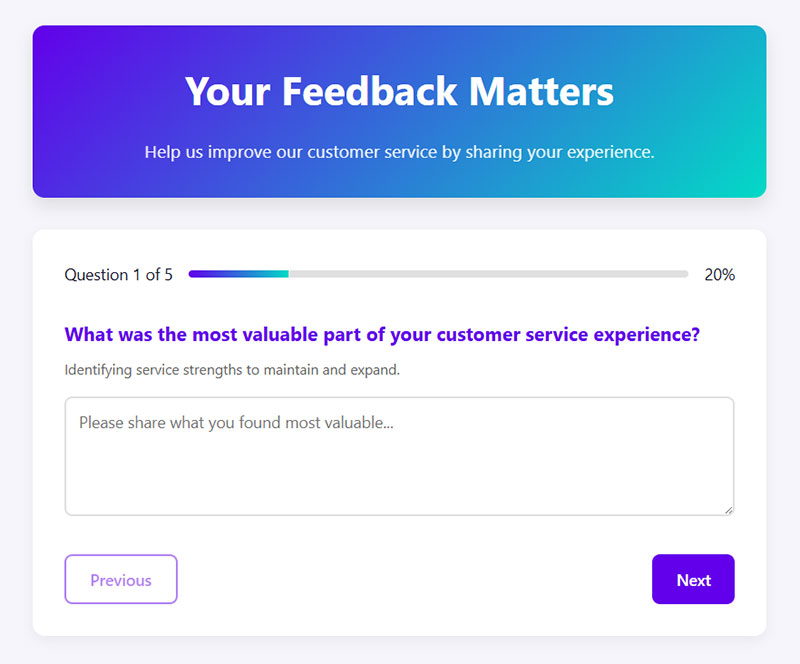
Improvement Suggestion
Question: What one thing could we have done better?
Type: Open-ended text field
Purpose: Identifies priority improvement areas from customer perspective.
When to Ask: End of survey.
Additional Comments
Question: Is there anything else you’d like to share about your experience?
Type: Open-ended text field
Purpose: Captures unexpected feedback and gives customers a voice.
When to Ask: Final question of survey.
Unresolved Concerns
Question: Do you have any remaining concerns or questions we haven’t addressed?
Type: Open-ended text field with Yes/No option first
Purpose: Identifies loose ends and provides opportunity for additional support.
When to Ask: Before survey completion.
Most Valuable Aspect
Question: What was the most valuable part of your customer service experience?
Type: Open-ended text field
Purpose: Identifies service strengths to maintain and expand.
When to Ask: End of survey.
Specific Team/Department Feedback
Question: If you interacted with multiple teams or departments, which one provided the best service and why?
Type: Dropdown for department selection with open text field
Purpose: Identifies internal best practices and performance variations.
When to Ask: For complex service interactions involving multiple departments.
FAQ on Customer Service Survey Questions
What makes an effective customer service survey?
Effective surveys balance brevity with depth. They incorporate form validation to ensure data quality and use clear satisfaction measurement scales. The best utilize multiple question types across key service quality dimensions while maintaining form accessibility. Customer effort metrics and sentiment analysis tools help extract maximum value from responses.
How many questions should a customer service survey include?
Keep it concise. Most effective survey form templates contain 5-10 questions to optimize response rates. Longer surveys dramatically increase abandonment. Consider using multi-step forms for more comprehensive data collection while maintaining user engagement through progressive disclosure techniques.
When is the best time to send customer service surveys?
Timing matters critically. Send post-interaction surveys within 24 hours when experiences remain fresh. For broader customer experience measurement, quarterly cadences work well. Many companies integrate a form builder with conditional logic to trigger surveys based on specific customer behaviors or touchpoints.
What’s the difference between CSAT, NPS, and CES metrics?
These represent distinct service quality indicators. CSAT measures specific interaction satisfaction. NPS evaluates overall loyalty through likelihood to recommend. CES assesses effort required to resolve issues. Each provides unique insights into support effectiveness measurement. Most robust Voice of Customer programs utilize all three for comprehensive evaluation.
How can I improve survey response rates?
Focus on form design principles that reduce friction. Keep surveys short, mobile-optimized, and visually clean. Personalize invitations, set clear expectations about survey length, and consider incentives for completion. Strong form submission confirmation messages also encourage future participation.
Should customer service surveys be anonymous?
Context matters here. Anonymous surveys often generate more honest feedback about support team performance and service quality assessment. However, non-anonymous formats allow targeted follow-up on specific customer complaints. Many organizations use both approaches through conditional logic that gives respondents control over identification.
What types of questions work best in customer service surveys?
Mix several question types for comprehensive feedback collection. Use Likert scales for satisfaction metrics, multiple-choice for focused options, and open-ended questions for qualitative insights. Balance quantitative consumer response evaluation with spaces for detailed commentary. WordPress survey plugins support all these formats.
How should we analyze customer service survey results?
Move beyond basic averages. Segment data by customer demographics, issue types, and support channels. Track trends over time using customer experience analytics. Look for correlation between metrics and business outcomes. Consider using specialized web forms with built-in analysis features to streamline this process.
What are good follow-up questions for negative survey responses?
When feedback indicates problems, dig deeper with specific questions targeting root causes. Ask about resolution satisfaction, service improvement suggestions, and what would have created a better outcome. Many feedback form templates include conditional sections that appear only after negative responses to capture critical improvement opportunities.
How can survey data improve customer service operations?
Transform insights into action through dedicated feedback implementation processes. Present findings regularly to support teams, incorporate data into training, and establish clear service quality benchmarks based on results. Create structured review cycles to assess how changes impact satisfaction metrics over time. The best companies build comprehensive customer feedback management systems.
Conclusion
Well-crafted customer service survey questions form the backbone of impactful consumer response evaluation programs. By implementing strategic post-purchase surveys and client experience evaluation tools, organizations gain invaluable insights that drive meaningful improvements.
Service quality assessment requires both art and science. The most successful organizations balance:
- Quantitative measurements through GDPR compliant forms that respect customer privacy
- Qualitative insights via thoughtfully designed forms that capture nuanced feedback
- Systematic analysis using robust customer experience analytics
Your support effectiveness measurement strategy should evolve continuously. As customer expectations shift, so must your approach to gathering feedback. Remember that response time satisfaction and resolution quality feedback represent critical dimensions of the overall experience. By treating each form submission as an opportunity for improvement, you transform passive data collection into a powerful engine for service excellence.
